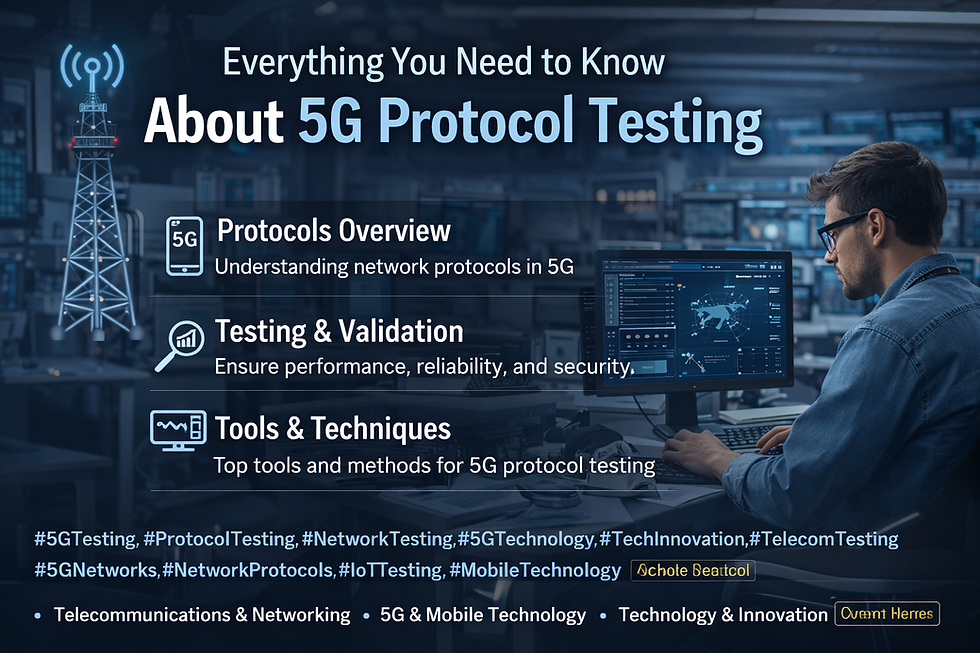The Economics of 5G Telco Cloud Deployment in 2024
- Sameer Krishn
- Jun 18, 2024
- 3 min read
Updated: Jun 27, 2024

Table of Contents
Introduction
Cost Analysis of 5G Telco Cloud Deployment
Economic Benefits of 5G Telco Cloud
Financial Implications for Stakeholders
Conclusion
Introduction
As the world transitions to 5G technology, the deployment of 5G Telco Cloud is gaining significant traction. This transformative technology promises to revolutionize telecommunications, offering faster speeds, lower latency, and more reliable connections. However, deploying 5G Telco Cloud comes with its own set of economic considerations. In this blog, we will explore the costs, benefits, and financial implications of 5G Telco Cloud deployment in 2024.
Cost Analysis of 5G Telco Cloud Deployment
The deployment of 5G Telco Cloud involves significant upfront costs, but it also offers long-term economic benefits. Understanding the cost structure is essential for stakeholders to make informed decisions.
1. Infrastructure Investment
Deploying 5G Telco Cloud requires substantial investment in infrastructure, including the installation of new base stations, small cells, and fiber optic cables. The cost of these components varies based on geographic location, population density, and existing infrastructure. According to TeleGeography, the global investment in 5G infrastructure is expected to reach $250 billion by 2025.
2. Spectrum Acquisition
Acquiring the necessary spectrum for 5G deployment is another significant cost. Governments auction off spectrum licenses, and telecom operators must compete to secure the bandwidth needed for 5G services. The cost of spectrum can be substantial, with recent auctions in the United States generating billions of dollars in revenue for the government.
3. Operational Expenses
In addition to capital expenditures, telecom operators face ongoing operational expenses related to the maintenance and management of 5G networks. This includes costs for power consumption, site rentals, and labor. However, the operational efficiency of 5G networks can help offset some of these expenses through energy savings and automated network management.
Economic Benefits of 5G Telco Cloud
While the initial costs of deploying 5G Telco Cloud are high, the economic benefits can be substantial. This technology has the potential to drive economic growth and create new opportunities across various sectors.
1. Enhanced Connectivity
5G Telco Cloud provides enhanced connectivity, enabling faster and more reliable communication. This can improve productivity and efficiency in industries such as manufacturing, healthcare, and transportation. For example, in manufacturing, real-time data analytics and remote monitoring can optimize production processes and reduce downtime.
2. Innovation and New Services
The deployment of 5G Telco Cloud paves the way for innovative services and applications. Technologies such as the Internet of Things (IoT), augmented reality (AR), and virtual reality (VR) rely on the high-speed, low-latency capabilities of 5G. These innovations can create new revenue streams for businesses and enhance the overall consumer experience.
3. Economic Growth and Job Creation
The rollout of 5G infrastructure can stimulate economic growth and job creation. According to a report by the GSMA, 5G is expected to contribute $2.2 trillion to the global economy by 2034. This growth will be driven by increased productivity, new business models, and improved services. Additionally, the deployment of 5G networks will create jobs in construction, engineering, and technology sectors
Financial Implications for Stakeholders
The financial implications of 5G Telco Cloud deployment extend to various stakeholders, including telecom operators, investors, and consumers.
1. Telecom Operators
For telecom operators, the deployment of 5G Telco Cloud represents both an opportunity and a challenge. On one hand, operators can benefit from new revenue streams and improved network efficiency. On the other hand, they must manage the significant capital and operational expenses associated with 5G rollout. Strategic partnerships and collaborations with technology vendors and infrastructure providers can help mitigate some of these costs.
2. Investors
Investors in the telecommunications sector can expect both risks and rewards from the deployment of 5G Telco Cloud. While the initial investment is high, the long-term economic benefits and potential for growth make 5G a promising opportunity. Investors should consider the financial health and strategic positioning of telecom operators when making investment decisions.
3. Consumers
Consumers stand to benefit from the enhanced services and improved connectivity offered by 5G Telco Cloud. However, they may also face higher costs for devices and data plans as operators pass on some of the deployment expenses. Despite this, the overall consumer experience is expected to improve, with faster internet speeds, lower latency, and access to innovative services.
Conclusion
The deployment of 5G Telco Cloud in 2024 presents both economic opportunities and challenges. While the initial costs are high, the long-term benefits, including enhanced connectivity, innovation, and economic growth, are substantial. Stakeholders, including telecom operators, investors, and consumers, must navigate the financial implications to maximize the potential of this transformative technology.
Internal URLs:
Apeksha Telecom's training programs: https://www.apekshatelecom.com/training
Apeksha Telecom's placement assistance: https://www.apekshatelecom.com/placement-assistance
External URLs:
Telecom Gurukul: https://www.telecomgurukul.com
Reference URLs:
"The Economics of 5G Telco Cloud Deployment" - Apeksha Telecom: https://www.telecomgurukul.com/post/the-economics-of-5g-telco-cloud-deployment




Comments